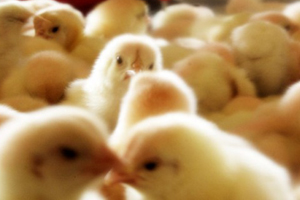Study: Energy availability from DDGS for broiler chicks

Researchers at Purdue University have determined the amount of metabolisable energy available to young broiler chickens from dried corn distillers grains (DDG) and dried corn distillers grains with solubles (DDGS).
Currently, more than 35% of the annual US corn crop is being used for ethanol production, resulting in less and more expensive corn for use in diets for poultry and other livestock. As a result, poultry growers have turned to DDG and, more often, DDGS, both by-products of the ethanol production process, to provide an economically affordable substitute. The challenge, however, has been to accurately determine the energy content of these fermentation by-products.
“The energy and nutrients of different components of the feed are extracted at different parts of the bird’s digestive tract, and not all of the energy in the feed is actually available to the bird. For example, when feed moves from the ileum to the cecum and large intestine, microbes in the gut will extract a significant portion of the nutrients for their own energy needs. It turns out that the most accurate measure of the energy in DDG and DDGS available to the bird is the “ileal digestible energy” or IDE, most of which can be utilised by the animal. Hence, determining the IDE value was the focus of our research,” said Dr Layi Adeola, the article’s lead author and a professor in Purdue’s Department of Animal Sciences.
IDE reflects the energy digested and absorbed in the gastrointestinal tract up to the ileum. In addition to IDE, the researchers determined the metabolisable energy (ME) and nitrogen-corrected metabolisable energy (MEn) contents of corn DDG and DDGS. All determinations were for 6-week-old broiler chickens using a multiple linear regression method. In each case the researchers found a roughly 500 kcal-per-kg of DM (dry matter) difference between DDG and DDGS, with DDGS having the higher value.
In an earlier study, the authors studied the ME and MEn using 3-week-old broilers and found significant differences compared with the current study, leading them to conclude that the ability of broilers to extract energy from these by-products varies with age.
Studies have shown that when the solubles are added back to corn DDG, the fat content rises from approximately 8% to 10.5% in corn DDGS. Due to the significant increase in fat prices concomitant with the increase in the cost of corn, some DDGS producers are skimming off some of the oil and selling it directly to growers rather than adding it back to DDGS.
“The result,” said Dr Adeola, “is that the fat content of DDGS on the market is getting progressively lower – down from around 10% to just 4-5%, which of course impacts the amount of energy that will be available to the bird. The DDGS in our study had a fat content of around 10%, so growers should keep this in mind and be aware of the fat content of the DDGS that they are buying. Given that fat is not preferentially used as an energy source by gut microbes, it will be interesting to see in future studies if the differential in IDE and MEn of fat extracted DDGS is similar to what was observed in high oil products.”
Source: Poultry Science Association












